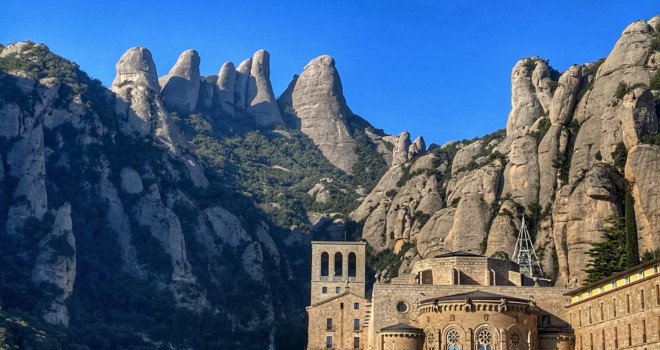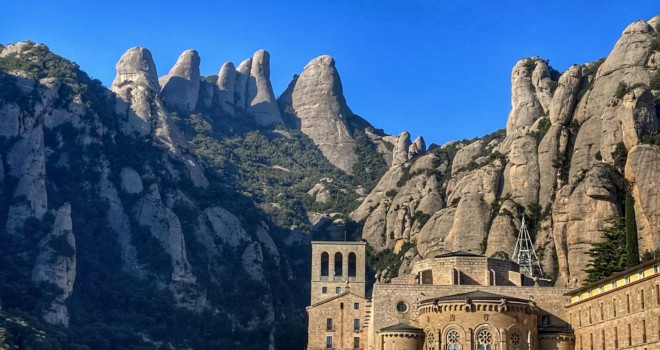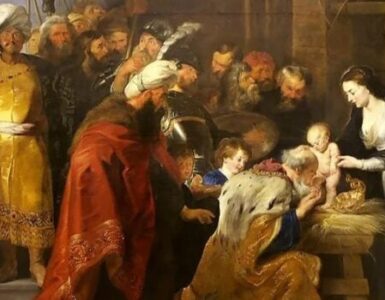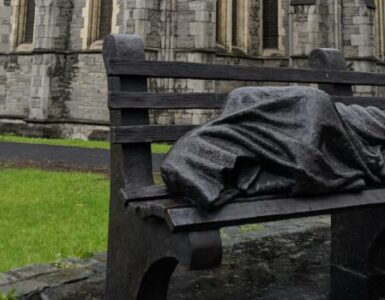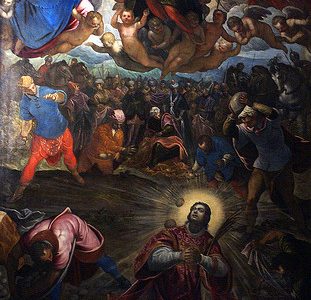Montserrat, the “serrated mountain”, near Barcelona in Spain symbolizes the vital power of the Church. Even after seemingly hopeless periods of decline, Our Lord leads her back again to her mission of salvation far beyond all known boundaries. What will the Marian shrine of La Moreneta on Catalonia’s Holy Mountain teach us today? Mysteriously, Our Lady of Montserrat brought the faith even to the New World. For it was the hermit Bernat Boïl (1440/45-1507/9) of Montserrat who accompanied Christopher Columbus (1451-1506) on his second voyage and planted devotion to La Moreneta in the soil of the newly discovered continent. On January 6, 1494, he said the First Holy Mass in the New World in La Isabela, the first Christian settlement of the Americas.
The Scenery of an Impossible Redemption
The quite improbable landscape of Montserrat captivated our visitors from afar. It seemed fantastic and otherworldly. Like a rocky ridge, it rose abruptly and in isolation from the Catalan hill country and the valley of the Rio Llobregat – bold and keen as a monstrous castle, 10 km long and up to 5 km wide. Traditionally, Montserrat is considered the Montsalvatsch of the Legend of the Holy Grail. To Wolfram von Eschenbach’s (c.1160/80-c.1220) knight Parzival, the Castle of the Holy Grail might have appeared like Montserrat to the traveller: “The fortress that he saw before him, like smoothly turned it stood there, unapproachably defying every storm. Many a palace and many a tower rises up with wonderful defense.”
The Grail, a stone from the crown of Lucifer, which Jesus saw falling like lightning (Luke 10,18), fell to earth during Lucifer’s fall to hell. From it was cut the bowl in which Christ changed the wine into his precious blood at the Last Supper, according to the legend, while Joseph of Arimathea collected Christ’s blood in it under the cross. It is quite understandable that the Catalans see in Montserrat the mountain of the Christ’s temptation. From the Castillo del Diabolo, a group of rocks high above the Monastery of the Virgin Mary, Lucifer is said to have shown Christ all the kingdoms of the earth.
The hermitages scattered in rocky niches and over summit heights also awaken in our German travelers the thought of the chorus of “Holy Hermits” in the closing scene of Faust, the greatest German drama, the tragedy of modern man. “Forests, they wave around, / Over them, cliffs bear down, / Roots cling to rocky ground, / Trunk upon trunk is bound, / Wave after wave sprays up, / Deep caves protecting us.” (Translation) But how surprised they were to learn that Goethe actually had Montserrat in mind when he finished Faust, poetic material which had gripped him from his youth, and let it end there at the end of his own life – redeemed in spite of everything. And Goethe was aware of La Moreneta.
How did Goethe come to the idea of having Montserrat as the scenery of the “impossible” redemption of the epitome of the modern man poetically shaped by the Weimarian classic? Why does he frequently speak of an “ideal Montserrat” in his letters and describes approvingly “attitudes”, “in which alone man can find happiness and peace on his own Montserrat”?
Goethe never saw Montserrat with his own eyes. It was Wilhelm von Humboldt (1767-1835), who conveyed to him the idea of this mountain and what it stands for, in a long letter describing his ascent of Montserrat in the year 1800. For the Prussian Protestant von Humboldt, the architect of the Humboldtian education ideal that became a model also in the United States, the climb is more than an external flow of impressions.
The crosses “which holy bold hands have erected on naked rocky peaks at dizzy heights, to which all access seems denied to man”, reminded him of verses by his friend Goethe. “The sign he sees erected here on high / That brings consoling hope to all mankind, / Which many thousands pledged their lives to shield, / To which in fervour prayed the human mind, / That has destroyed the bitter powers of death, / On victors’ banners fluttered in the wind: / A stream of comfort permeates his being, / He sees the cross and bows his head in seeing.” Von Humboldt’s descriptions make the deepest impression on Goethe.
The time around 1830, when Goethe creates the closing scene of Faust, reveals the dark sides of a new era that has led to the present. The triumph of industry, the machine age, growing mobility, acceleration, condensation of communication, growth of cities, the penetration of the masses into politics and the public sphere – all this made clear that a new age was truly beginning. The spirit of economy, social utility, and practical living were booming. Goethe shows the nefariousness of such progress in Faust’s murder of Philemon and Baucis, who seek refuge in their chapel: “Let’s make our way to the chapel, / To watch the last glow of light, / Kneel, pray, and sound the bell, / And trust in God’s ancient might!” But this is precisely what Faust cannot bear: “How can I drive it from my nature! / The bell peals, and I’m an angry creature.”
When in “Dead of Night” Lynceus, the Warder, “for seeing, I’m born, / For watching, employed,” is seized by “horror, meant to terrify,” our travelers, re-reading the passage, think of the ecclesiastical and societal catastrophes beginning in 1960ies and reaching until today: “The little chapel now collapses, / With the falling branches’ weight. / Already with bright snakelike flashes, / The treetops, gripped, meet their fate. / Glowing crimson, to their hollow / Roots, the trunks now burn with ease. – / (A long pause. Chant.) / What used to please my eyes, below, / Has vanished with the centuries.”
Will La Moreneta Also Save Modern Man?
The brave new world of Goethe’s Faust, however, bought with such a ruthless sacrifice, creates only superficial relief, but above all unprecedented threats. In Faust’s building of dikes against the elements, the modern risk society emerges, in which worry is omnipresent as precaution. Goethe’s drama even anticipates “transhumanism,” the design of artificial humans in the laboratory, and has Faust and Mephisto, the devil that bought Faust’s soul, invent the lucrative, but fragile financial system of our time. And when the lemurs dig Faust’s grave, Mephisto seems to triumph fully: “You’ll be lost in every way – / The elements are ours, today, / And ruin comes on running feet.”
But still Goethe grants Faust a literary redemption at least; in the final scene Faust’s soul is snatched from damnation, though “the fearful jaws of Hell open on the left”, as the stage instructions say. Goethe painted with words, what Hieronymus Bosch (c.1450-1516) painted in colors: “The tusks yawn wide: the jaws of the abyss, / Flow with raging flames, in fury, / And in the boiling background hiss, / I see the eternal glow of the fiery city.” How is the epitome of modern man improbably, even seemingly impossibly, and despite all that he thought and did, granted redemption in the “Mountain Gorges, Forest, Rock, Desert (Holy Hermits, divided in ascending planes, posted among the ravines.)”, i.e., in the scenery of Montserrat?
Goethe does not expect his contemporaries to understand his literary solution. “The day is really so absurd and confused that I am convinced that my honest, long pursued efforts for this strange building will be badly rewarded and driven onto the beach, lying there like a wreck in ruins, and will first be overwhelmed by the dune debris of the hours,” he writes in the last letter of his life about the conclusion of Faust, addressed to von Humboldt on March 17, 1832. His last diary entry, “spent the whole day in bed due to indisposition,” dates from the same day. Five days later Goethe died.
Is it La Moreneta, then, who saves Faust and perhaps also modern man? Is it she whom Doctor Marianus in the drama worships, “Bowing, in adoration”: “Gaze towards that saving gaze, / All you, the penitent and tender, / To all those blissful ways, / Give thanks, and follow after. / Let every finer sense, unseen, / Be offered to her service, / Virgin, Mother now, and Queen, / Goddess, grant your mercies!” The invocation “Goddess” makes clear, of course, how little Goethe is rooted in the Catholic world. Nevertheless, by him, as by every great poet, something supra-personal and universally valid finds a voice. In any case, it is La Moreneta that Humboldt has described to Goethe thirty years before: “The sacred image is of wood, and like most others of this kind, of black color on hands and face […] The features of it are pure and noble. I need not tell you in what holiness it has been kept for centuries by the faithful.”
Goethe’s closing scene of his Nordic version of the Don Juan myth is more deeply moving than the ending in which Mozart and his librettist Da Ponte let their Don Giovanni go to hell. And it fits well to Miguel Mañara from Seville, whom La cieguecita, the little blind woman, looked at, from which the same looks as from La Moreneta: “With a gold saw, the little angels cut / Those hills, so as to build you a palace. / Queen of Heaven, taken from earth by the Seraphim, / Give us shelter under your blue veil,” sings the Virolai. Eya pietatis oculo placato cerne ligatos fune peccatorum – “Oh, look with the reconciled eye of Your motherly love upon those bound by the fetters of their sins”, as in the canon O virgo splendens sings.
The deep impression of Faust’s “impossible” redemption has made on the cultural consciousness is reflected by Gustav Mahler’s (1860-1911) Symphony No. 8 in E-flat, composed near his own death (first US Performance: Philadelphia 1916). One of the largest-scale choral works in the classical repertoire, the piece is in two parts, instead of the conventional framework of several movements. Part II is an impressive setting of the words from the closing scene of Goethe’s Faust. Listen: https://www.youtube.com/watch?v=NSYEOLwVfU8.
Around the same time when Goethe finished the drama of his life, Our Lady appeared to the novice Catherine Labouré (1806-1876) at the Motherhouse of the Vincentian Sisters on the Rue du Bac in Paris on July 19 and November 27, 1830. “The medal that Mary had spoken about with her confidante was minted and distributed millions of times throughout the world,” explained Pope Pius XII at her canonization in 1947, “where it was soon the cause of so many extraordinary gifts of grace, both spiritual and physical, so many healings, so much assistance and, above all, so many conversions.”
Isn’t this strange and moving temporal coincidence of literary redemption and the beginning of the Marian era something to be contemplated by a believing heart? Perhaps the proclamation of Mary’s Assumption in 1950 will be followed by the dogma of Maria co-redemptrix solemnly proclaimed by a new pope, heralding the promised triumph of Her Immaculate Heart.
✠
Editor’s note: This article is the final part in a three-part series, “The Mystery of Montserrat.” You can read future parts of this series each Friday or subscribe to Catholic Exchange’s email list to receive future articles.
Dorothea and Wolfgang Koch have also contributed two previous in-depth series for Catholic Exchange, which we highly recommend:
- Sagrada Família: A Symbol of Rediscovered Faith, documenting the influence of St. Joseph in the building of the monumental Sagrada Familia in Spain.
- Fatima: The Immaculate Heart for the World, an article series exploring the inspiration of artist Fr. Thomas McGlynn, O.P. in creating the large statue of Our Lady of Fatima with direction from Sr. Lucia, one of the Fatima Visionaries.


